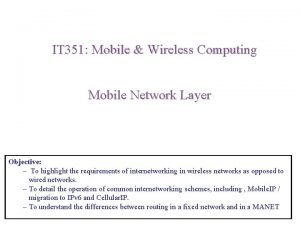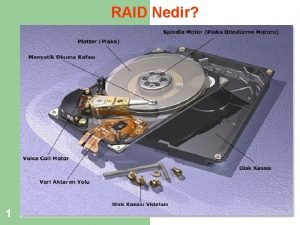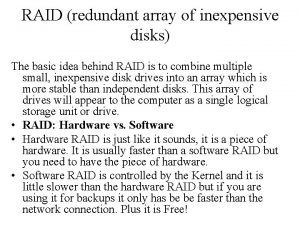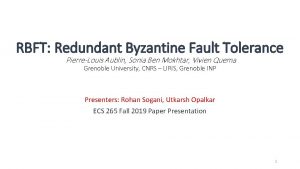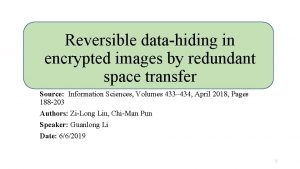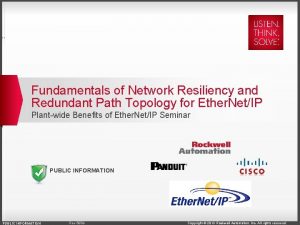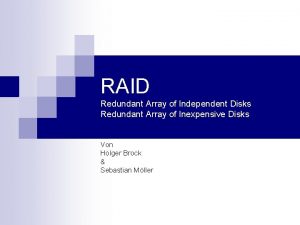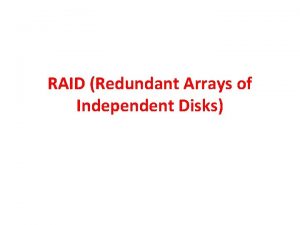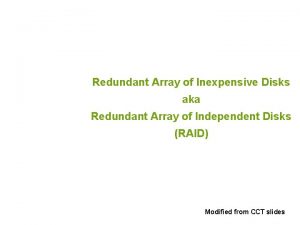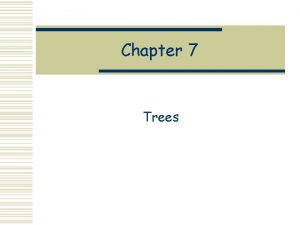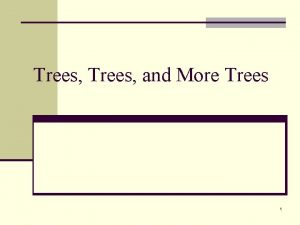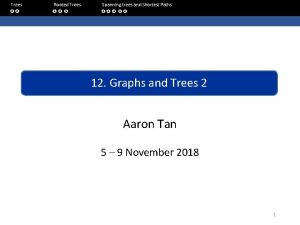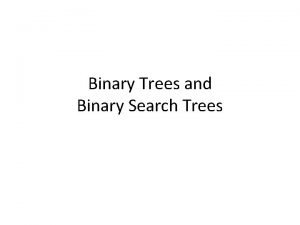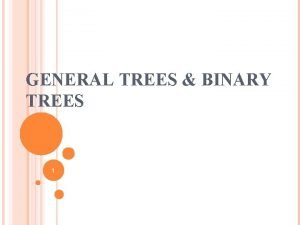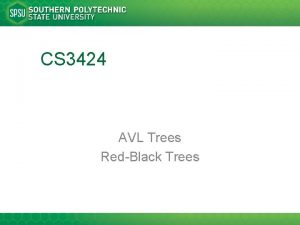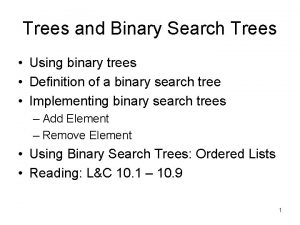Algorithms for computing Maximally Redundant Trees for IPLDP

























- Slides: 25

Algorithms for computing Maximally Redundant Trees for IP/LDP Fast-Reroute draft-enyedi-rtgwg-mrt-frr-algorithm-00 Gábor Sándor Enyedi egboeny@ericsson. com Alia Atlas akatlas@juniper. net András Császár eandcss@ericsson. com

MRT • Maximally Redundant Trees – A pair of directed spanning trees – The common root is reachable along both of them – The two paths along the two trees are maximally disjoint e root d a f g c k j b h i

Why do we need this draft? • We need a pair of MRTs rooted at each node – All the nodes should compute the same! – We will need standardization for MRT computation (algorithm) or results of that computation.

Principles Partial order ADAG Blocks and GADAG

Partial order • Partial order of a set (e. g. set of nodes) – A relation like a normal set – Except: not all the elements can be compared • For some a and b neither a<b nor a>b • Graph representation: – Directed Acyclic Graph (DAG) max e d min a f c b • min<a<b<f<c<e<max • a<d<e

Finding node-disjoint paths • Suppose that – We have a partial order of nodes – Exactly one min and max – Each node (except min and max) has a lower and greater neighbor • Walk down and up – Min and max are reached – The two paths are node-disjoint! max e d min a f c b • min<a<b<f<c<e<max • a<d<e

Two paths to the same node • DAG is not enough – Let min and max be the same node! • Resulting graph is an Almost DAG (ADAG) – There is a single node, the root, such that without the root it is a DAG max e root d min a f c b • root<a<b<f<c<e<root min<a<b<f<c<e<max • a<d<e

Redundant paths to the root • Blue path: – Nodes must increase • Red path: – Nodes must decrease • Load sharing is possible e root d a f c b

Finding an ADAG (2 -connected networks) • Phase 1 – basic partial ADAG – Find a partial ADAG for a cycle containing the root • Use either direction – Extend partial ADAG into all nodes e root d a f c b

Finding an ADAG (2 -connected networks) • Phase 2 – extending – Find a path from one “ready” node to the another – Nodes along the path must not be ready (except the endpoints) – Add the path to the ADAG in a “proper” direction e root d a f c b

Adding not used links • Some links may be out of the ADAG e root d f c a BAD! OKe<f b

How can ordering be kept up? • ADAG is almost a DAG – Let root be now only the smallest one – Now, it’s a DAG, create a topological sort – This is a total order • Add extra links with respect to this Add back links to root and we have an ADAG using all links. 1 root 7 5 e 4 d a 2 f c 6 b 3

What if the network is not 2 -connected? • We need to split the graph into blocks – Block: • Maximally 2 -connected subgraph • Two connected nodes • (Isolated node) – Each block has its local-root • That is the cut-vertex towards the root – Compute an ADAG in all the blocks – This is a Generalized ADAG

Generalized ADAG e root d a f g c k j b • Block 1: root, a, b, c, d, e, f • Block 2: f, g • Block 3: g, h, i, j, k h i

The algorithm MRTs in a block MRTs in the whole network

How to Find MRTs • If it is complex, then we break the problem down – Transform network into its blocks – Find ADAGs in each block – Connect up the ADAGs to make a GADAG – Add all the other links in – with the proper directionality • From a GADAG, compute your next-hops to each destination – First for those in the same block – Destinations outside the block inherit their nexthops from a proxy in the block

How to Find MRTs • If it is complex, then we break the problem down – Transform network into its blocks – Find ADAGs in each block – Connect up the ADAGs to make a GADAG – Add all the other links in – with the proper directionality • From a GADAG, compute your next-hops to each destination – First for those in the same block – Destinations outside the block inherit their nexthops from a proxy in the block

MRTs in a single block • As the computing router S: From the GADAG, can use SPF and reverse SPF to find next-hops to all destinations in the same block – SPF gives nodes definitely greater – r. SPF gives nodes definitely lesser – Remaining nodes are not ordered • Then use some simple rules

MRTs in a single block: source perspective • • Find greater and lesser nodes Rules 1. 2. 3. 4. 5. If S < D – If S > D – No order – If D=root – If S=root – increase to D increase to root decrease to root increase to D + e + - root 0 d - a f c - b - decrease to root decrease to D increase to root decrease to D Routing table of node c (S = c): Dest (D) Rule Used Blue Next-hop Red Next-hop a 2 e b b 2 e b d 3 b e e 1 e b f 2 e f root 4 e b

MRTs in a single block: destination perspective • • Find greater and lesser nodes Rules 1. 2. 3. 4. 5. If S < D If S > D No order If d=root If s=root – – – increase to D increase to root decrease to root increase to D decrease to root decrease to D increase to root decrease to D Destination: node c (D = c) e root d a f c b Src (S) Rule Used Blue Next-hop Red Next-hop a 1 b root b 1 c a d 2 a e e 3 root c f 2 c e root 1 a e

How to Find MRTs • If it is complex, then we break the problem down – Transform network into its blocks – Find ADAGs in each block – Connect up the ADAGs to make a GADAG – Add all the other links in – with the proper directionality • From a GADAG, compute your next-hops to each destination – First for those in the same block – Destinations outside the block inherit their nexthops from a proxy in the block

Inter-block MRTs Proxy node: the last vertex in the block to the destination (along any path) Dest (D) Rule Used Blue Next-hop Red Nexthop Dest (D) Proxy Blue Nexthop Red Nexthop a 2 e b g f e f b 2 e b h f e f d 3 b e i f e 1 e b j f e f f 2 e f k f e f root 4 e b e root d a f g c k j b h i

Example – destination is node C e root d a f g c k j b • Block 1: root, a, b, c, d, e • Block 2: e, f • Block 3: f, g, h, i, j h i

Summary • Algorithm – Find GADAG • ADAG in each block • Add not used links – Find next-hops along the MRTs • Do an SPF and an r. SPF to find ordered nodes • Use rules to find NHs your block • Find proxy nodes

Thanks for the attention
 Total order
Total order Learned laziness
Learned laziness Redundant link
Redundant link Raid nedir
Raid nedir Removing redundant attributes in entity sets
Removing redundant attributes in entity sets Redundant arrays of independent disks
Redundant arrays of independent disks A case for redundant arrays of inexpensive disks
A case for redundant arrays of inexpensive disks Redundant publications
Redundant publications Redundant byzantine fault tolerance
Redundant byzantine fault tolerance Atbem
Atbem Rockwell automation
Rockwell automation Holger brock
Holger brock Prime implicant
Prime implicant Redundant prepuce phimosis and paraphimosis
Redundant prepuce phimosis and paraphimosis Geo
Geo Redundant equation
Redundant equation Conventional computing and intelligent computing
Conventional computing and intelligent computing Datorkunskap för nybörjare
Datorkunskap för nybörjare Magnetsjukhus
Magnetsjukhus Humanitr
Humanitr Ekologiskt fotavtryck
Ekologiskt fotavtryck Steg för steg rita
Steg för steg rita Blomman för dagen drog
Blomman för dagen drog Redogör för vad psykologi är
Redogör för vad psykologi är Geometri för barn
Geometri för barn Claes martinsson
Claes martinsson


